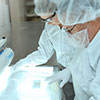Ace+Method+Development+Kits
Supplier:
TCI America
Description:
CAS Number: 17536-00-4
MDL Number: MFCD00671516 Molecular Formula: C9H16N2 Molecular Weight: 152.24 Purity/Analysis Method: >98.0% (GC,T) Form: Crystal Melting point (°C): 88
Supplier:
TCI America
Description:
CAS Number: 668-94-0
MDL Number: MFCD00005198 Molecular Formula: C15H12N2 Molecular Weight: 220.28 Purity/Analysis Method: >98.0% (HPLC,T) Form: Crystal Melting point (°C): 234
Supplier:
TCI America
Description:
CAS Number: 14351-66-7
MDL Number: MFCD00058941 Molecular Formula: C20H30O2 Molecular Weight: 324.44 Purity/Analysis Method: >95.0% (T) Form: Crystal
Catalog Number:
(10353-366)
Supplier:
Bioss
Description:
Non-receptor protein-tyrosine kinase that plays an essential role in regulating cell migration, adhesion, spreading, reorganization of the actin cytoskeleton, formation and disassembly of focal adhesions and cell protrusions, cell cycle progression, cell proliferation and apoptosis. Required for early embryonic development and placenta development. Required for embryonic angiogenesis, normal cardiomyocyte migration and proliferation, and normal heart development. Regulates axon growth and neuronal cell migration, axon branching and synapse formation; required for normal development of the nervous system. Plays a role in osteogenesis and differentiation of osteoblasts. Functions in integrin signal transduction, but also in signaling downstream of numerous growth factor receptors, G-protein coupled receptors (GPCR), EPHA2, netrin receptors and LDL receptors. Forms multisubunit signaling complexes with SRC and SRC family members upon activation; this leads to the phosphorylation of additional tyrosine residues, creating binding sites for scaffold proteins, effectors and substrates. Regulates numerous signaling pathways. Promotes activation of phosphatidylinositol 3-kinase and the AKT1 signaling cascade. Promotes activation of MAPK1/ERK2, MAPK3/ERK1 and the MAP kinase signaling cascade. Promotes localized and transient activation of guanine nucleotide exchange factors (GEFs) and GTPase-activating proteins (GAPs), and thereby modulates the activity of Rho family GTPases. Signaling via CAS family members mediates activation of RAC1. Recruits the ubiquitin ligase MDM2 to P53/TP53 in the nucleus, and thereby regulates P53/TP53 activity, P53/TP53 ubiquitination and proteasomal degradation.
Catalog Number:
(10353-372)
Supplier:
Bioss
Description:
Non-receptor protein-tyrosine kinase that plays an essential role in regulating cell migration, adhesion, spreading, reorganization of the actin cytoskeleton, formation and disassembly of focal adhesions and cell protrusions, cell cycle progression, cell proliferation and apoptosis. Required for early embryonic development and placenta development. Required for embryonic angiogenesis, normal cardiomyocyte migration and proliferation, and normal heart development. Regulates axon growth and neuronal cell migration, axon branching and synapse formation; required for normal development of the nervous system. Plays a role in osteogenesis and differentiation of osteoblasts. Functions in integrin signal transduction, but also in signaling downstream of numerous growth factor receptors, G-protein coupled receptors (GPCR), EPHA2, netrin receptors and LDL receptors. Forms multisubunit signaling complexes with SRC and SRC family members upon activation; this leads to the phosphorylation of additional tyrosine residues, creating binding sites for scaffold proteins, effectors and substrates. Regulates numerous signaling pathways. Promotes activation of phosphatidylinositol 3-kinase and the AKT1 signaling cascade. Promotes activation of MAPK1/ERK2, MAPK3/ERK1 and the MAP kinase signaling cascade. Promotes localized and transient activation of guanine nucleotide exchange factors (GEFs) and GTPase-activating proteins (GAPs), and thereby modulates the activity of Rho family GTPases. Signaling via CAS family members mediates activation of RAC1. Recruits the ubiquitin ligase MDM2 to P53/TP53 in the nucleus, and thereby regulates P53/TP53 activity, P53/TP53 ubiquitination and proteasomal degradation.
Catalog Number:
(10353-342)
Supplier:
Bioss
Description:
Non-receptor protein-tyrosine kinase that plays an essential role in regulating cell migration, adhesion, spreading, reorganization of the actin cytoskeleton, formation and disassembly of focal adhesions and cell protrusions, cell cycle progression, cell proliferation and apoptosis. Required for early embryonic development and placenta development. Required for embryonic angiogenesis, normal cardiomyocyte migration and proliferation, and normal heart development. Regulates axon growth and neuronal cell migration, axon branching and synapse formation; required for normal development of the nervous system. Plays a role in osteogenesis and differentiation of osteoblasts. Functions in integrin signal transduction, but also in signaling downstream of numerous growth factor receptors, G-protein coupled receptors (GPCR), EPHA2, netrin receptors and LDL receptors. Forms multisubunit signaling complexes with SRC and SRC family members upon activation; this leads to the phosphorylation of additional tyrosine residues, creating binding sites for scaffold proteins, effectors and substrates. Regulates numerous signaling pathways. Promotes activation of phosphatidylinositol 3-kinase and the AKT1 signaling cascade. Promotes activation of MAPK1/ERK2, MAPK3/ERK1 and the MAP kinase signaling cascade. Promotes localized and transient activation of guanine nucleotide exchange factors (GEFs) and GTPase-activating proteins (GAPs), and thereby modulates the activity of Rho family GTPases. Signaling via CAS family members mediates activation of RAC1. Recruits the ubiquitin ligase MDM2 to P53/TP53 in the nucleus, and thereby regulates P53/TP53 activity, P53/TP53 ubiquitination and proteasomal degradation. Phosphorylates SRC; this increases SRC kinase activity. Phosphorylates ACTN1, ARHGEF7, GRB7, RET and WASL.
Catalog Number:
(10353-346)
Supplier:
Bioss
Description:
Non-receptor protein-tyrosine kinase that plays an essential role in regulating cell migration, adhesion, spreading, reorganization of the actin cytoskeleton, formation and disassembly of focal adhesions and cell protrusions, cell cycle progression, cell proliferation and apoptosis. Required for early embryonic development and placenta development. Required for embryonic angiogenesis, normal cardiomyocyte migration and proliferation, and normal heart development. Regulates axon growth and neuronal cell migration, axon branching and synapse formation; required for normal development of the nervous system. Plays a role in osteogenesis and differentiation of osteoblasts. Functions in integrin signal transduction, but also in signaling downstream of numerous growth factor receptors, G-protein coupled receptors (GPCR), EPHA2, netrin receptors and LDL receptors. Forms multisubunit signaling complexes with SRC and SRC family members upon activation; this leads to the phosphorylation of additional tyrosine residues, creating binding sites for scaffold proteins, effectors and substrates. Regulates numerous signaling pathways. Promotes activation of phosphatidylinositol 3-kinase and the AKT1 signaling cascade. Promotes activation of MAPK1/ERK2, MAPK3/ERK1 and the MAP kinase signaling cascade. Promotes localized and transient activation of guanine nucleotide exchange factors (GEFs) and GTPase-activating proteins (GAPs), and thereby modulates the activity of Rho family GTPases. Signaling via CAS family members mediates activation of RAC1. Recruits the ubiquitin ligase MDM2 to P53/TP53 in the nucleus, and thereby regulates P53/TP53 activity, P53/TP53 ubiquitination and proteasomal degradation. Phosphorylates SRC; this increases SRC kinase activity. Phosphorylates ACTN1, ARHGEF7, GRB7, RET and WASL.
Catalog Number:
(10327-986)
Supplier:
Bioss
Description:
URG4 may be involved in cell cycle progression through the regulation of cyclin D1 expression. It may participate in the development of hepatocellular carcinoma (HCC) by promoting hepatocellular growth and survival. URG4 may play an important role in development of gastric cancer.
Catalog Number:
(10338-642)
Supplier:
Bioss
Description:
URG4 may be involved in cell cycle progression through the regulation of cyclin D1 expression. It may participate in the development of hepatocellular carcinoma (HCC) by promoting hepatocellular growth and survival. URG4 may play an important role in development of gastric cancer.
Catalog Number:
(10327-990)
Supplier:
Bioss
Description:
URG4 may be involved in cell cycle progression through the regulation of cyclin D1 expression. It may participate in the development of hepatocellular carcinoma (HCC) by promoting hepatocellular growth and survival. URG4 may play an important role in development of gastric cancer.
Supplier:
Shenandoah Biotechnology
Description:
Sonic hedgehog (SHH) is a member of a small group of hedgehog secreted proteins that are essential for development in both vertebrates and invertebrates. There are three mammalian hedgehog homologues, sonic, desert, and indian, that signal via the Patched-1 and Patched-2 receptors. SHH is a morphogen that is essential during vertebrate organogenesis and adult stem cell division.
Supplier:
TCI America
Description:
CAS Number: 627-64-5
MDL Number: MFCD00025527 Molecular Formula: C4H6N2O2 Molecular Weight: 114.10 Purity/Analysis Method: >96.0% (N) Form: Crystal
Supplier:
TCI America
Description:
CAS Number: 19833-78-4
Molecular Formula: C4H11N Molecular Weight: 201.05 Purity/Analysis Method: >97.0% (N,T) Form: Crystal Melting point (°C): 175
Supplier:
Mortech Manufacturing
Description:
CutMATE forceps were developed to overcome the variability of tissue specimen thickness. They will allow cutting consistent tissue specimen thickness of 2, 3, or 4 mm.
Catalog Number:
(TCE0128-025G)
Supplier:
TCI America
Description:
CAS Number: 26392-49-4
MDL Number: MFCD00060201 Molecular Formula: C8H19N Molecular Weight: 165.71 Purity/Analysis Method: >97.0% (N,T) Form: Wax
Catalog Number:
(TCP0587-025G)
Supplier:
TCI America
Description:
CAS Number: 3468-63-1
MDL Number: MFCD00059524 Molecular Formula: C16H10N4O5 Molecular Weight: 338.28 Purity/Analysis Method: >93.0% (E) Form: Crystal Melting point (°C): 306 Lambda max.: 480 nm (CHCl3)
Inquire for Price
Stock for this item is limited, but may be available in a warehouse close to you. Please make sure that you are logged in to the site so that available stock can be displayed. If the
Stock for this item is limited, but may be available in a warehouse close to you. Please make sure that you are logged in to the site so that available stock can be displayed. If the
You must log in to order restricted items. We request that you provide the required business documentation to purchase this product for the first time.
To order chemicals, medical devices, or other restricted products please provide identification that includes your business name and shipping address via email CMD_NA@vwr.com or fax 484.881.5997 referencing your VWR account number . Acceptable forms of identification are:
-Additional Documentation May be needed to purchase this item. A VWR representative will contact you if needed.
This product has been blocked by your organization. Please contact your purchasing department for more information.
The original product is no longer available. The replacement shown is available.
This product is currently unavailable but limited stock may be available in our extended warehouse network. Please call 1-800-932-5000 and a VWR Customer Service Representative will help you.
|
|||||||||


































